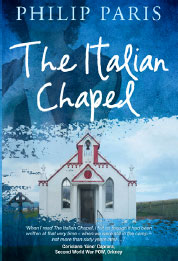They were brought to the island as ‘the enemy’ and by the time they left they would have developed relationships and connections that continue to endure today between the inhabitants of the Orkney Islands and Moena, the Italian mountain village where the artist and decorator Domenico Chiocchetti originally came from and where he returned after the war.
 Philip Paris has written both a non-fiction account of the short history of the Italian Chapel on Lamb Holm and this book, the novel I have just read and adored. The fictional form allows the author to imagine some of the relationships for which there is little detail and create others that may have been.
Philip Paris has written both a non-fiction account of the short history of the Italian Chapel on Lamb Holm and this book, the novel I have just read and adored. The fictional form allows the author to imagine some of the relationships for which there is little detail and create others that may have been.
It is a war-time story without guns, battles and tragedy, it could even be said it depicts what war purports to be all about, a strategy to create peace and establish tolerance and what better conduit to promote acceptance than to build a chapel, whose sole purpose is for prayer and reflection, a sanctuary from the day-to-day reality.
550 Italian soldiers are captured during WW2 in Egypt and sent to Camp 60 on Lamb Holm, Orkney Islands where they live in ramshackle Nissen huts and are used as free labour to build barriers between the islands to prevent entry to the mainland from invading forces.
“The nearest land is mainland Orkney, which is also an island. You will know from your journey that we are a long way from Italy. You’re all here to do a job, to help build a unique set of barriers between mainland Orkney to the north and between the islands to the south of Glimps Holm, Burray and South Ronaldsay. Four barriers in all.”
In the opening pages, bulldozers arrive with instructions to raze camp 60 to the ground, leaving no trace of the former POW camp. The Italian Chapel sits there beside the Nissen huts awaiting its fate. We then learn the story of how it came to be there.
The novel introduces us to key characters in the camp, the artist Domenico Chiocchetti from the northern Italian village of Moena who keeps a small prayer card his mother gave him, with the image of the Madonna’s face in his pocket throughout the war, retrieving it at moments when he needed to escape the present, or remember the past and whose image will become a symbol of the thing he leaves behind, the only physical reminder that there was a POW camp on the Scottish island during the war.
We meet Aldo, who doesn’t talk about his family, but can source anything the men require, Buttapasta, a cement and stone artist, Giuseppe the romantic who had been a foundry worker in the US, they will all become instrumental in the project that occupies the men when the causeway barriers are complete and their status changes after Mussolini is sacked and the Italians are no longer the enemy. The men decide to create a chapel out of two unused Nissen huts and scraps from shipwrecks and whatever their captors can source.
The prayer card becomes the inspiration for Chiocchetti’s portrait of the Madonna and child, painted on plasterboard behind the altar. An altar is made from concrete left over from building the Barriers, tiles are rescued from a sunken blockship ( a ship deliberately sunk to prevent access to a channel) and wood salvaged from a shipwreck is transformed into a tabernacle. Carved lanterns are created from Bully Beef tins and candlesticks made from the brass stair rods, all contributing to create a beautiful and peaceful interior.
It is a story of optimism, incredible resourcefulness and the things men do to keep their spirits up when the circumstances are against them. It is an easy, light read and moving without being overly sentimental and knowing this wonderful refuge actually exists made it all the more meaningful and special for me as a reader.
Philip Paris has researched this period in history and tried to track down those who were on the island or their relatives and creates a memorable and heartfelt story of tough times that are lightened by a mutual desire to build not just a chapel, but a refuge of incredible beauty that can still be visited today.
“It was the prisoner’s escape, a tunnel to spiritual and cultural freedom, while their bodies remained in captivity.”


